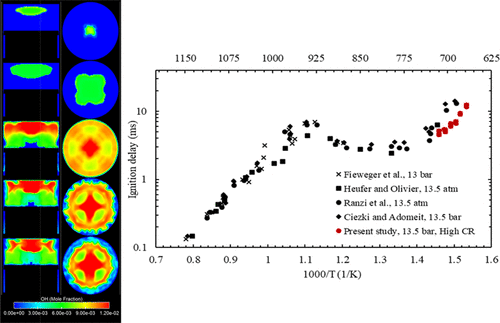当前位置:
X-MOL 学术
›
Ind. Eng. Chem. Res.
›
论文详情
Our official English website, www.x-mol.net, welcomes your feedback! (Note: you will need to create a separate account there.)
Measurement and Simulation of n-Heptane Mixture Autoignition
Industrial & Engineering Chemistry Research ( IF 4.2 ) Pub Date : 2021-09-15 , DOI: 10.1021/acs.iecr.1c02943 Maysam Molana 1 , Tusharr Goyal 1 , Omid Samimi-Abianeh 1
Industrial & Engineering Chemistry Research ( IF 4.2 ) Pub Date : 2021-09-15 , DOI: 10.1021/acs.iecr.1c02943 Maysam Molana 1 , Tusharr Goyal 1 , Omid Samimi-Abianeh 1
Affiliation

|
The autoignition of n-heptane mixtures was studied over a wide range of conditions using a rapid compression machine (RCM). The experiments were performed using several n-heptane mixtures at average compressed gas pressures of 6.55 and 13.35 bar, compressed gas temperatures ranging from 605 to 757 K, equivalence ratio of one, and two inert dilution ratios of 79, and 84%. Two detailed kinetic mechanisms (LLNL and NUI Galway kinetic models) were used to simulate the measured data. Three-dimensional (3-D) and zero-dimensional (0-D) computational fluid dynamics models were used to simulate the autoignition at the studied conditions. The mechanism models performed well using 84% diluted mixture at both pressures, while 79% dilution performed well only at lower pressure. The NUI Galway mechanism model predicts a longer ignition delay with respect to the measured data at most of the studied conditions. The modeled ignition delays are longer using 3-D model with respect to the 0-D model, which is due to the simulation of the flow pattern inside the combustion chamber. However, the difference between the two models becomes smaller at higher gas temperatures. The results show that the 3-D model is necessary to simulate the n-heptane mixture ignition delay and validate the kinetic model at the RCM low-temperature conditions. In addition, some of the measured ignition delays were compared with the shock tube data, and they are slightly shorter than the shock tube data.
中文翻译:

正庚烷混合物自燃的测量和模拟
使用快速压缩机 (RCM) 在各种条件下研究了正庚烷混合物的自燃。实验使用几个n-庚烷混合物,平均压缩气体压力为 6.55 和 13.35 巴,压缩气体温度范围为 605 至 757 K,当量比为 1,两种惰性稀释比为 79% 和 84%。两种详细的动力学机制(LLNL 和 NUI Galway 动力学模型)用于模拟测量数据。三维 (3-D) 和零维 (0-D) 计算流体动力学模型用于模拟研究条件下的自燃。使用 84% 稀释混合物在两种压力下的机理模型都表现良好,而 79% 稀释仅在较低压力下表现良好。NUI Galway 机制模型预测在大多数研究条件下相对于测量数据有更长的点火延迟。相对于 0-D 模型,使用 3-D 模型的建模点火延迟更长,这是由于模拟了燃烧室内的流动模式。然而,在较高的气体温度下,两种模型之间的差异变得更小。结果表明 3-D 模型对于模拟正庚烷混合物点火延迟并验证 RCM 低温条件下的动力学模型。另外,一些测得的点火延迟与激波管数据进行了比较,它们比激波管数据略短。
更新日期:2021-09-29
中文翻译:

正庚烷混合物自燃的测量和模拟
使用快速压缩机 (RCM) 在各种条件下研究了正庚烷混合物的自燃。实验使用几个n-庚烷混合物,平均压缩气体压力为 6.55 和 13.35 巴,压缩气体温度范围为 605 至 757 K,当量比为 1,两种惰性稀释比为 79% 和 84%。两种详细的动力学机制(LLNL 和 NUI Galway 动力学模型)用于模拟测量数据。三维 (3-D) 和零维 (0-D) 计算流体动力学模型用于模拟研究条件下的自燃。使用 84% 稀释混合物在两种压力下的机理模型都表现良好,而 79% 稀释仅在较低压力下表现良好。NUI Galway 机制模型预测在大多数研究条件下相对于测量数据有更长的点火延迟。相对于 0-D 模型,使用 3-D 模型的建模点火延迟更长,这是由于模拟了燃烧室内的流动模式。然而,在较高的气体温度下,两种模型之间的差异变得更小。结果表明 3-D 模型对于模拟正庚烷混合物点火延迟并验证 RCM 低温条件下的动力学模型。另外,一些测得的点火延迟与激波管数据进行了比较,它们比激波管数据略短。



























 京公网安备 11010802027423号
京公网安备 11010802027423号